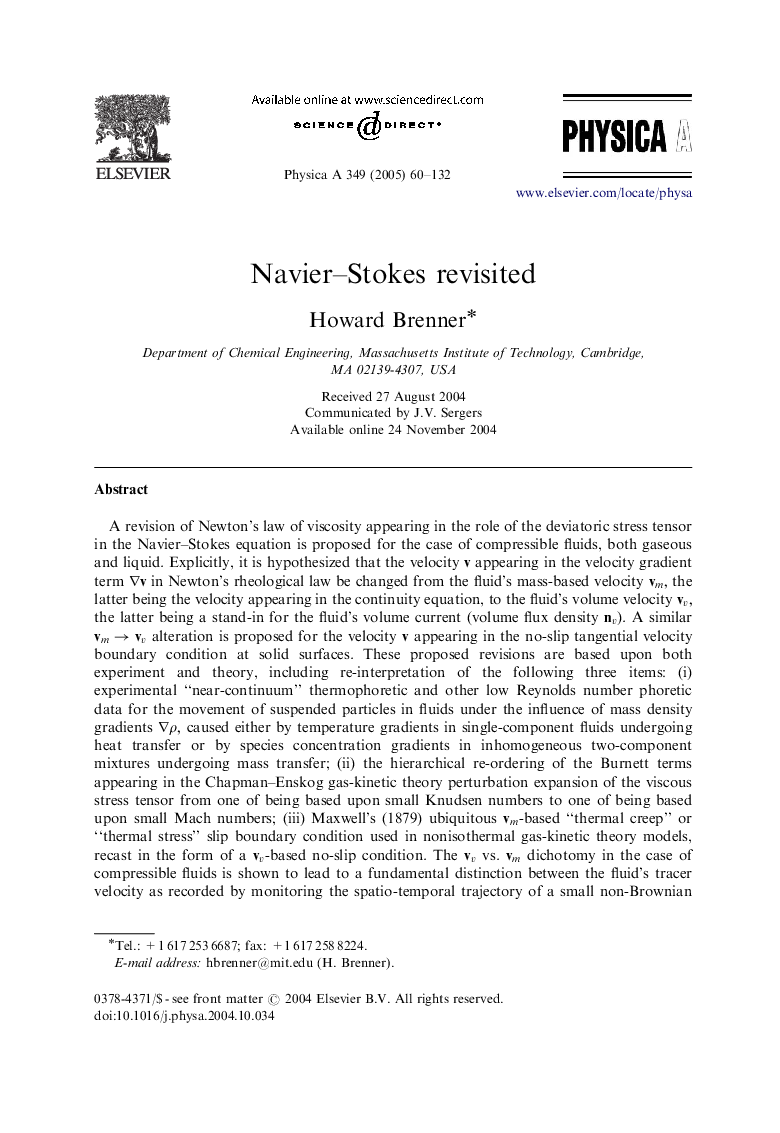| کد مقاله | کد نشریه | سال انتشار | مقاله انگلیسی | نسخه تمام متن |
|---|---|---|---|---|
| 9727869 | 1480212 | 2005 | 73 صفحه PDF | دانلود رایگان |
عنوان انگلیسی مقاله ISI
Navier-Stokes revisited
دانلود مقاله + سفارش ترجمه
دانلود مقاله ISI انگلیسی
رایگان برای ایرانیان
کلمات کلیدی
موضوعات مرتبط
مهندسی و علوم پایه
ریاضیات
فیزیک ریاضی
پیش نمایش صفحه اول مقاله

چکیده انگلیسی
A revision of Newton's law of viscosity appearing in the role of the deviatoric stress tensor in the Navier-Stokes equation is proposed for the case of compressible fluids, both gaseous and liquid. Explicitly, it is hypothesized that the velocity v appearing in the velocity gradient term âv in Newton's rheological law be changed from the fluid's mass-based velocity vm, the latter being the velocity appearing in the continuity equation, to the fluid's volume velocity vv, the latter being a stand-in for the fluid's volume current (volume flux density nv). A similar vmâvv alteration is proposed for the velocity v appearing in the no-slip tangential velocity boundary condition at solid surfaces. These proposed revisions are based upon both experiment and theory, including re-interpretation of the following three items: (i) experimental “near-continuum” thermophoretic and other low Reynolds number phoretic data for the movement of suspended particles in fluids under the influence of mass density gradients âÏ, caused either by temperature gradients in single-component fluids undergoing heat transfer or by species concentration gradients in inhomogeneous two-component mixtures undergoing mass transfer; (ii) the hierarchical re-ordering of the Burnett terms appearing in the Chapman-Enskog gas-kinetic theory perturbation expansion of the viscous stress tensor from one of being based upon small Knudsen numbers to one of being based upon small Mach numbers; (iii) Maxwell's (1879) ubiquitous vm-based “thermal creep” or “thermal stress” slip boundary condition used in nonisothermal gas-kinetic theory models, recast in the form of a vv-based no-slip condition. The vv vs. vm dichotomy in the case of compressible fluids is shown to lead to a fundamental distinction between the fluid's tracer velocity as recorded by monitoring the spatio-temporal trajectory of a small non-Brownian particle deliberately introduced into the fluid, and the fluid's “optical” or “colorimetric” velocity as monitored, for example, by the introduction of a dye into the fluid or by some photochromic- or fluorescence-based scheme in circumstances where the individual fluid molecules are themselves responsive to being probed by light. Explicitly, it is argued that the fluid's tracer velocity, representing a strictly continuum nonmolecular notion, is vv, whereas its colorimetric velocity, which measures the mean velocity of the molecules of which the fluid is composed, is vm.
ناشر
Database: Elsevier - ScienceDirect (ساینس دایرکت)
Journal: Physica A: Statistical Mechanics and its Applications - Volume 349, Issues 1â2, 1 April 2005, Pages 60-132
Journal: Physica A: Statistical Mechanics and its Applications - Volume 349, Issues 1â2, 1 April 2005, Pages 60-132
نویسندگان
Howard Brenner,